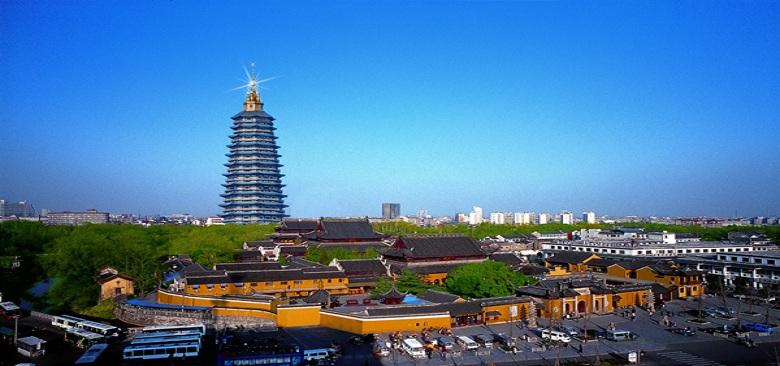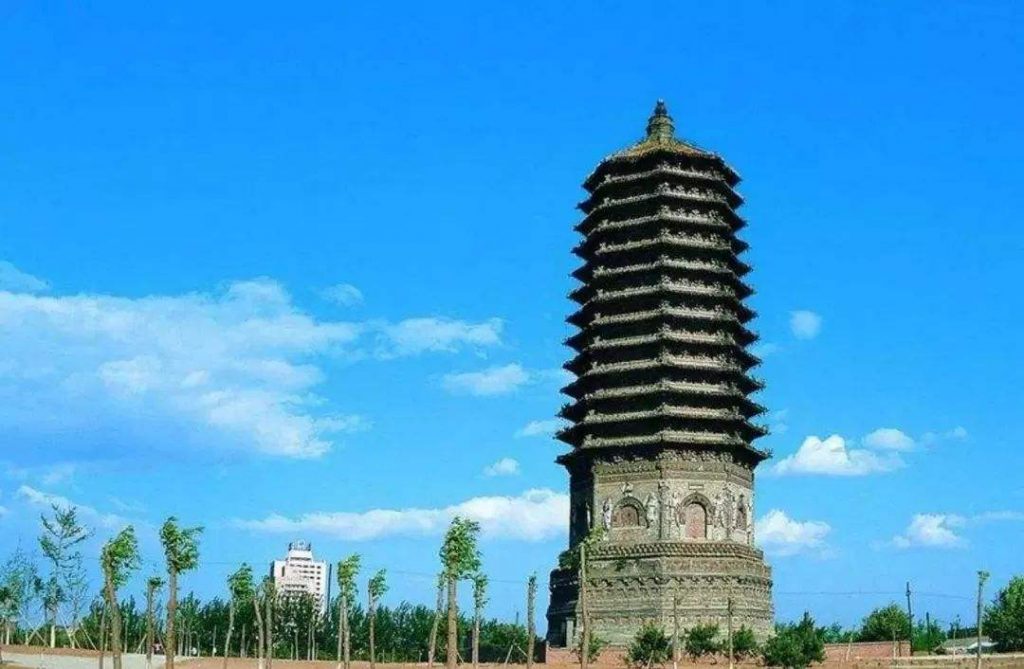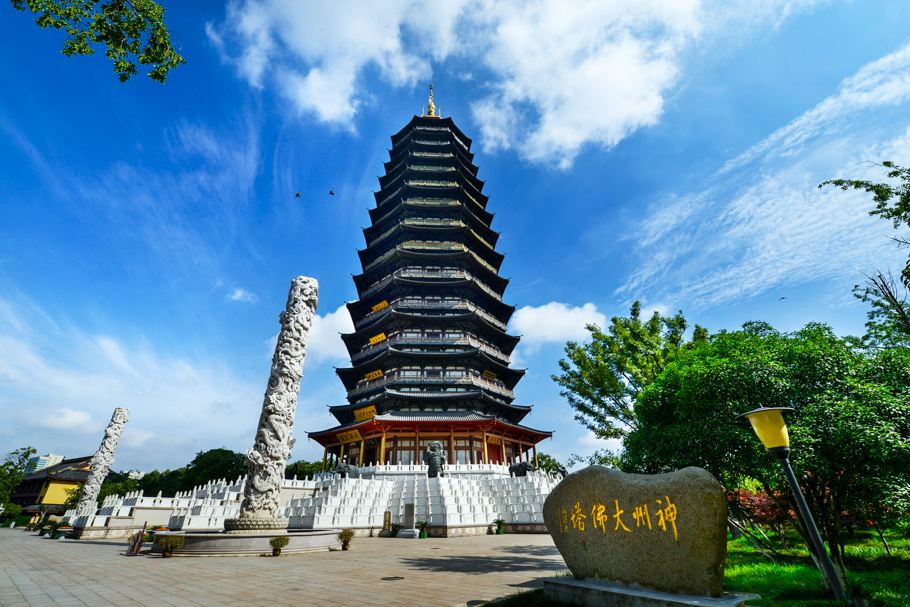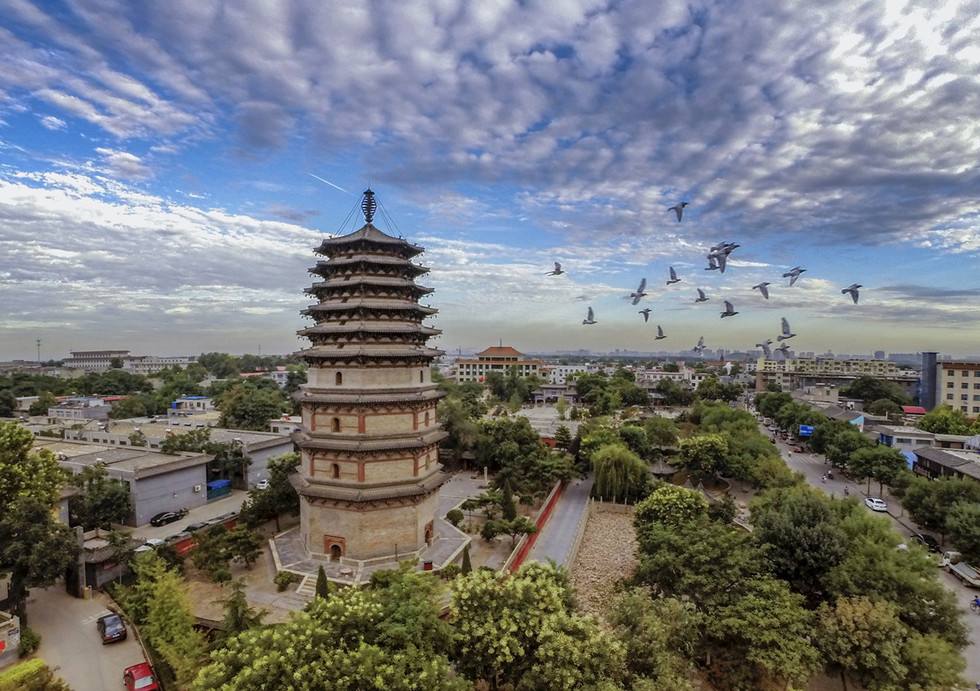Tianning Temple Pagoda
7 min readTianning Temple Pagoda is the tallest, earliest and most exquisitely-decorated pagoda in Beijing. It occupies an important place in Chinese ancient architectural history.
According to the inscriptions on steles, the pagoda was built in the Liao dynasty, renovated several times afterwards in the following dynasties and preserve until today. It is a 13-storied octagonal multieaved brick pagoda with a height of 57.8 meters. Its base is a throne of Mt. Sumeru, consisting of two layers. The second layer is relatively smaller than the first one. Those lotus-shaped brick carvings on the first layer are varied in appearances and vivid in gestures. Theyare of indeed the art treasure of brick carvings. There carved statues of Gods of Power and diamond clubs between the niches and at the corners on the second layer.

Unfortunately, all the God statues’ heads are destroyed. None survives! The whole base is carved with vivid statues and delicate patterns. The plenty of patterns and the excellence of skills are rarely seen among all the carvings in history. The platform on the base is surrounded by brick railings, on which delicate patterns of flowers are carved. Inside the railings is a three-storied opening lotus, with the body part locating in the middle.

This pagoda stands on the north and faces the south. Its first story is extremely large. There are two false doors in imitation of the wooden structures separately on the east, west, south and north sides of the pagoda and decorative patterns of rolled colored silk balls are carved on them.A statue of sitting Buddha and two statues of standing attendants are carved in the arches above the doors. In the niche on the front side, Buddha in the middle wears a five-Buddhas crown, his palms putting together in front of the chest with the sign of “wisdom fist”. This is Mahavairocara. Manjushri is on his left and Samantabhadra is on his right. These three statues are known as Three Saints of Huayan. In the niche on the west side, the middle one is Amitaba Buddha, putting one palm on the other under the umbilicus with the gesture of meditation.
Bodhisattva Avalokitesvara is on his left and Bodhisattva Mahasthamaprapta on his right. They are known as Three Saints in the West. In the niche on the north side, the one in the middle has 18 arms with a musical instrument in each hand. This is Candi-avalokitesvara. Candi means clean and refers to the clean heart of Avalokitesvara here. Candi-avalokitesvara is one of the six Bodhisattvas in Esoteric Buddhism. Two attendants, dragon kings Manakasyapa and Ananadaj, are standing on the both sides. In addition, there are two flying dragons on the ridge of the arches with their heads facing each other. In the middle is a precious flaming pearl, whichis quite vivid in appearance. On the top of the arches is a canopy, on both sides of which is a fairy with sacrifice on the hands and lucky clouds under the feet.
There stands on both sides of the gate a pottery brick ferocious gigantic Guardian. They are waving the arms and fists, awe inspiring looking with their eyeswidely open and muscles highly rose. In China they are well-known as Generals Heng and Ha according to their different expressions. These two generals are usually set beside the gate in Buddhist constructions in the hope that they can safeguard the solemnity of the monastery. It is for the same reason that these two statues are put on the two sides of the pagoda gate-to safeguard Buddha and the temple.
On each of the other four sides of the pagoda there is a false vertical lattice window, with clay statues of Buddhisattva standing on the both sides. These statues are elegant in gestures and peaceful in expression, standing quietly with theirsleeves down. They are in sharp contrast with the statues of the Gods of Power.

On the top of the false windows in the southeast and southwest sides, statues ofBodhisattva Man jusri, Samantabhadra and other attendants are carved. Bodhisattva Manjusri and Samantabhadra are sitting separately on lotus thrones on the back of a lion and an elephant, with their palms putting together. They are vivid in expression and looking forward peacefully. In front of them is a Sudhana and behind them is King Yuzhen, who has a straight nose and deep eyes. He holds reins in the hand, directing the lion and the elephant walking quickly. The lion is roaring with head turning around while the elephant is peaceful and tamed in expression.
Different from the general arrangement of the position in Buddhist monasteries that Bodhisattva Manjusri is on the left and Samantabhadra is on the right, in this carving, Samantabhadra is on the left side of Buddha while Bodhisattva Manjusri ison the right side. This arrangement shows that Samantabhadra is in higher position than Bodhisattva Manjusri.
On the top of the false windows in the northeast and northwest sides, five statues of figures are carved separately. They are said to be PratyekabuddhasBodhisattva of Perfect Enlightenment. These ten Pratyekabuddhas, together with Bodhisattva Manjusri and Samantabhadra, are known as the Twelve Pratyekabuddhas.
Except that Bodhisattva Manjusri sits on a lion and Bodhisattva Samantabhadra sits on an elephant, the rest ten Bhodisattvas all put their palms together, stand on lucky clouds, raise their head high and look forward in pious expressions.
At the corner of the pagoda, there is a semicircled column, on which galloping dragons are carved. One on the top and the other at the bottom, these two dragonslook at each other with heads gathering together and bare fangs, brandish claws, showing a powerful momentum. This carving is of high aesthetic value and fully demonstrates the excellent carving skills of Chinese ancient craftsmen.
There are 13 layers of eaves above the first story of the body part. Both the tiles and ornamentations of animals on the ridge are made of colored glaze. Bronzed bells hang under each rafter of the eaves, the number of which amounts to 2720.
Under each corner a big bell is hung and there are all together 104 big bells. All the bronze bells under the rafters are lost during the long time in history. Only 104 big ones under the corner are remaining. There are inscription characters on the bel1s. Some of them were cast in the Ming dynasty. In addition, niches are set up between each layer in the eaves. There are three niches between each layer of eaves except the first layer, where two niches are set up. Bronze statues are put in the niches. They are different in size, varied in expression and vivid in appearance, having a typical style of the statues in the Ming dynasty.
There is a throne of Mt. Sumeru shaped pinnacle in the center on the top of the pagoda. It dropped in the Tangshan Earthquake in 1976 and was installed back afterwards.
According to the historical records, there used to be two wonders in this pagoda. One is that the top of the pagoda would give out lights. It is said that in the Ming dynasty,a famous scholar Wang Shizhen had lived in Tianning Temple on his way to the capital. One night, it rained slightly. Suddenly, the bells under the eaves stopped tinkling and a sound like cricket came up from the bottom of the pagoda. He felt so strange that he went out, trying to find out what had happened.
He was surprised to see that the Buddhist wheels on the pinnacle were shining in a pale green and white glow. They sent out strange sound while shinning. Aftera while, the lights around the wheels died out gradually and the cricket sound underthe pagoda stopped too. Just at that time, the bells began to sing again. Puzzled atthis strange scene, Wang Shizhen could not figure out the reason and then recorded it in a poem.

Today, the original gilded pinnacle is changed into a brick one and most of the bronze bells under the eaves are lost. Therefore, it is impossible to confirm whether the pinnacle would give out lights. The other wonder is that the image ofthe pagoda would be inverted through the gate into the Hall of Avalokitesvara. In ancient times, this pagoda located in front of the Hall of Avalokitesvara. In the fine days, the image of the pagoda would be inverted into the hall at noon when the gate was closed. It was strange that all the images on the floor were inverted ones. Many believers were therefore attracted here to worship since these inverted images were hard to explain in a reasonable way. Not until the Northern Song dynasty did Shen Kuo,a famous ancient scientist come up with a convinced explanation in his Dream Pool Essays. He said that it was only a common optical phenomenon. The images of articles would invert when they went though thin cracks and small holes. Because of the chesses on the door and windows, the images of the pagoda naturally became inverted on the floor. Today, the majestic Hall of Avalokitesvara is no longer in existence. Therefore, the wonder of the inverted images of the pagoda cannot be seen any more either.








